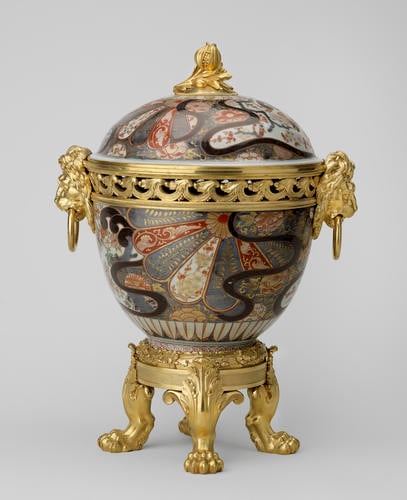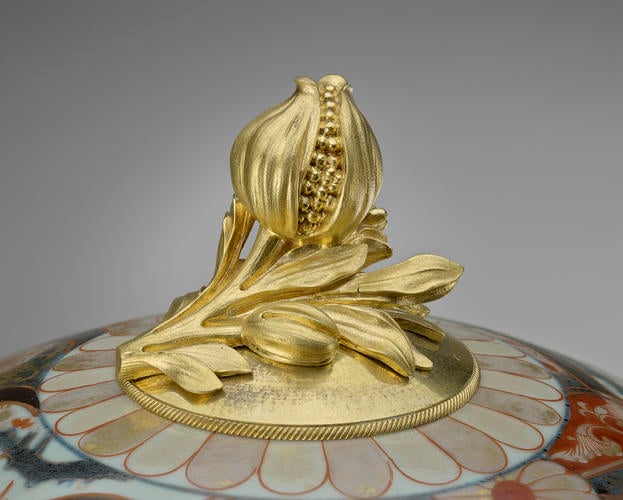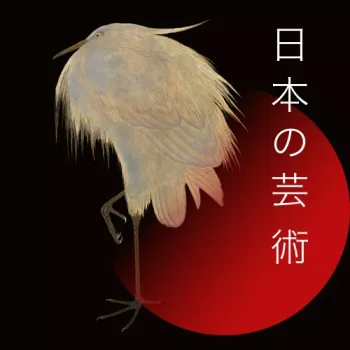Bowl and cover mounted as a pot-pourri bowl and cover: c.1690-1730, mounts: 1750-75
Porcelain painted in underglaze blue and overglaze enamels and gold, mounted in gilt bronze | 50.0 x 38.5 x 28.0 cm (whole object) | RCIN 45262
-
Radiating, oversized chrysanthemums are one of the most prevalent motifs on Edo-period export porcelain in the Imari style. Chrysanthemum plants had been brought to Japan from China during the Tang dynasty (619 – 907) and were admired for their resemblance to the sun – to the extent that they were sometimes called nikka (‘sun splendour’). Here, the large blue-grey and red petals are filled with stylised floral motifs, adding density to the rich enamel decoration. The undulating black lines which run from top to bottom are characteristic of Imari ware, which from the eighteenth century incorporated black enamel to achieve remarkably bold designs. Gold pigments would have been added only after the hottest initial firings, since they could not withstand the high temperatures sustained by the overglaze enamel. This vibrant style was copied widely in Europe during the eighteenth century, notably at the Worcester Porcelain Manufactory.
The bowl has been fitted with a perforated gilt-bronze band for use as a pot-pourri. Such items were popular in Britain from the late seventeenth century, when decorative pots were used to fill a room with fragrant perfume according to fashionable recipes. The gilt-bronze pomegranate on the lid is suggestive of the bowl’s sweet-smelling contents. No known bill or inventory records the item’s entry into the Royal Collection, but it is not uncharacteristic of the gilt-bronze mounted porcelain purchased by George IV in the early nineteenth century, and may have formed part of his collection at Brighton.
Bowl and cover, with rounded, rising sides, painted with half-chrysanthemums with petals in greyish blue and red, with leafy scrolls in gilt or white, divided by an undulating black line from one of long-tailed birds perching in prunus trees, with a petal-panel border below. The low, domed cover with spreading rim is painted to match. The cover is surmounted by a gilt-bronze pomegranate and leafy branch finial, with narrow rope-twist edge; the lower edge of the cover with a smooth, gilt-bronze, rebated edge and raised on an openwork band, which is fitted to the bowl, cast with a wave-like scroll pattern, similar to a ‘Vitruvian’ scroll, chased and hatched on both sides, with narrow rope-twist moulding below, each side with lion-mask handles with pendent rings hanging from their jaws; the foot fitted into an oak-leaf cast ring and circular burnished and mottled ring, raised on four naturalistic lion’s legs with paw feet, and headed by acanthus foliage.
Text adapted from Chinese and Japanese Works of Art in the Collections of Her Majesty The Queen: Volume II and Japan: Courts and Culture (2020)Provenance
Possibly acquired by George IV
-
Creator(s)
(nationality)(metalworker)Acquirer(s)
-
Medium and techniques
Porcelain painted in underglaze blue and overglaze enamels and gold, mounted in gilt bronze
Measurements
50.0 x 38.5 x 28.0 cm (whole object)
Place of Production
Arita [Saga, Japan]











